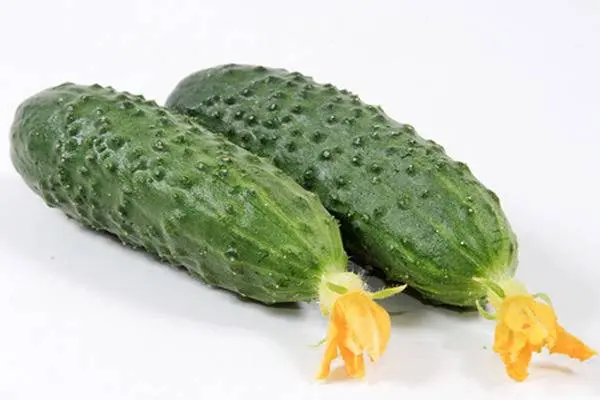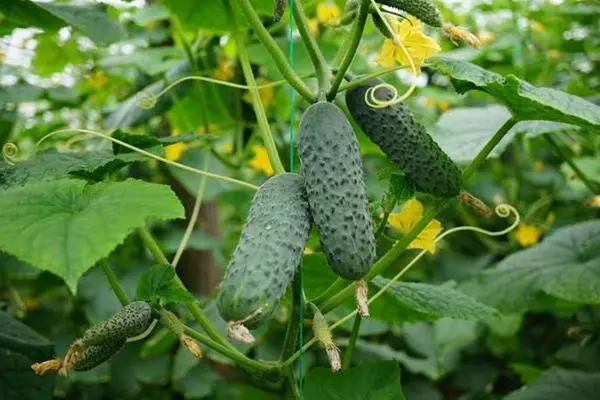Contents
Among the abundance of cucumber varieties, each gardener chooses a favorite that he constantly plants. And most often – these are early varieties that allow you to enjoy tasty and crispy vegetables from the beginning of summer.
Variety description
The early ripe Marinda hybrid grows well and bears fruit both in open ground and in greenhouse structures, it is distinguished by medium climbing. Vegetables can be grown horizontally or vertically. Marinda F1 does not require pollination for fruit set. With proper care, 5-7 fruits are tied in each knot. The period from seed germination to the appearance of the first cucumbers is approximately one and a half months.
Dark green cucumbers of the hybrid variety Marinda grow cylindrical, 8-11 cm long, weighing 60-70 g. On the surface of the fruit there are large tubercles with small white spikes (photo).

The crunchy pulp of a dense structure has small seed chambers and is not bitter. Variety Marinda F1 can be attributed to universal. Cucumbers are delicious fresh and well suited for conservation.
The yield of the variety is 25-30 kg per square meter. Cucumbers of the hybrid variety Marinda are resistant to many diseases (powdery mildew, leaf spot, cladosporiosis, scab, mosaic).
Growing seedlings
Seeds are planted in the last days of April-early May. To take into account the climatic features of the region, it is recommended to start planting grains 3-3,5 weeks before transplanting seedlings into open ground. For cucumbers of this hybrid variety, it is advisable to independently prepare the soil. It is necessary to take equally peat, garden soil and sand. Granular seeds of Marinda F1 from manufacturers have a special thin layer containing a set of nutrients, antifungal / antimicrobial agents. Therefore, such seeds can be sown immediately in open ground.

Landing steps:
- Separate containers are filled with a nutrient soil composition and lightly moistened. In plastic cups, holes are necessarily made in the bottom. If you use one large box, then as a result of subsequent picking, the sprouts can take root for a long time.
- Holes are made in the soil (1,5-2 cm), where 2 grains of Marinda F1 are placed at once. Planting material is sprinkled with earth.
- The containers are covered with foil or glass and placed in a warm place. Usually, after 3-4 days, the first shoots of Marinda hybrid cucumbers already appear. The cover from the containers is removed and the seedlings are transferred to a well-lit place.
- After the appearance of the first leaves, the seedlings are thinned out – a strong one is left of two sprouts. In order not to damage the root system of the remaining seedling, a weak sprout is simply cut off or carefully pinched off.

If you follow the correct light and temperature conditions, then the seedlings of Marinda hybrid cucumbers will be strong and healthy. Suitable conditions: temperature + 15-18˚ C, bright daylight. But you should not put seedlings in direct sunlight. In cloudy weather, it is recommended to use fitolamps day and night.
About a week and a half before planting seedlings in open soil, they begin to harden it. To do this, cucumbers of the hybrid variety Marinda are taken out into the street (the “walk” time is gradually increased daily).
Care for cucumbers
For cucumber beds, well-lit areas are allocated, protected from cold winds and drafts. The Marinda hybrid grows best in nutritious, well-drained soils with a low nitrogen content.
Seedlings with 3-4 leaves are considered strong enough, it can be planted in open ground (towards the end of May-beginning of June). Manufacturers recommend focusing on soil temperature – the soil should warm up to + 15-18˚ C. If the seedlings are overexposed, the foliage may begin to turn yellow.
The beds for cucumbers of the hybrid variety Marinda are prepared in advance: they dig shallow trenches into which a little compost, rotted manure, is poured. When planting seedlings, it is recommended to adhere to the scheme: in a row, the distance between the sprouts is 30 cm, and the aisle is made 50-70 cm wide. After planting, the ground around the roots is carefully compacted and watered.
Watering rules
Only warm water is used to moisten the soil. During the season, Marinda F1 cucumbers are watered differently:
- before flowering and under the condition of hot weather, it is recommended to water the cucumber beds daily. It is advisable to pour half a liter under each bush – a liter of water (4-5 liters per square meter);
- during the formation of the ovary of cucumbers of the hybrid variety Marinda and during harvesting, the frequency of irrigation is reduced, but at the same time the volume of water is increased. Once every two or three days, water is poured out at the rate of 8-12 liters per square meter;
- since mid-August, the abundance of irrigation and frequency has been reduced. It is enough to pour 3-4 liters per square meter once a week (or 0,5-0,7 liters under each bush).
Water under the cucumbers of the hybrid variety Marinda should be poured with a weak stream so as not to destroy the root system, which is located shallow. Watering on the leaves can be done only in the evening (when the heat of the day subsides, but the temperature does not drop very much).
Soil fertilization
Timely application of fertilizers will ensure the healthy growth of cucumbers of the hybrid variety Marinda and abundant fruiting. Top dressing is applied in two ways: basal and foliar.
The first top dressing of the Marinda hybrid variety cucumber in the open field is carried out during the period of growing green mass. But don’t do it recklessly. If the plant was planted in fertilized soil and is developing well, then it is not recommended to use fertilizers. If the seedlings are thin and weak, then complex compositions are used: ammofoska (1 tbsp. L) is diluted in 10 liters of water. Organic fertilizer fans can use a solution of bird droppings (1 part fertilizer to 20 parts water).
During the flowering of cucumbers of the hybrid variety Marinda, the growth of foliage and stems stops and therefore a mixture of mineral fertilizers is used: potassium nitrate (10 g), a glass of ash, ammonium nitrate (20 g), superphosphate (30 g) are taken for 40 liters of water.
To increase the formation and growth of ovaries of cucumbers Marinda F1, use a solution: for 10 liters of water, take potassium nitrate (25 g), urea (50 g), a glass of ash. Foliar top dressing will help to prolong fruiting at the end of the season (the last days of August and the beginning of September): the green mass is sprayed with a solution of urea (15 g per 10 liters of water).
When foliar feeding, it is important to choose the right time: early in the morning or in the evening. If it rains after the procedure, it is recommended to repeat the spraying.
Recommendations for growing
When planting Marinda F1 cucumbers in greenhouses, trellises must be installed, since the stems are placed vertically. Pillars 1,5-2 m high are placed along the beds. Tie cucumbers begin a week after planting seedlings. When forming a bush of cucumber Marinda F1, one stem is left, which is pinched as soon as it grows to the top of the trellis. As a rule, shoots and flowers are removed in the axils of the first three leaves.
Cucumbers of the hybrid variety Marinda, planted in open ground, are not recommended to pinch – so as not to injure the plant. However, if the plant has grown 6-8 leaves, and lateral shoots have not formed, then the top can be pinched.
Growing cucumbers vertically requires more attention and experience. Therefore, cucumber beds in the open field are the best option for beginner gardeners to get an excellent crop of Marinda hybrid cucumbers.









